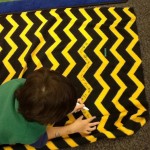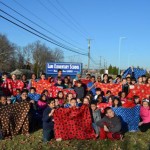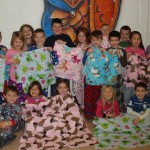Iditarod’s Education Department ran a service learning project for interested schools. The project, “Blankets for Dogs”, invited schools to supplement the supplies at checkpoints by making and sending blankets to be used in checkpoints. More than 1300 blankets were sent to Iditarod during January and February. The fleece blankets were shipped out to checkpoints with the other supplies. These blankets were used to provide another layer of comfort to the dogs left in checkpoints. (Dropped Dogs) Although checkpoints are already supplied with items such as this, the supplemental supply of blankets were welcomed and used to help make the dropped dogs a little more comfortable during their stay. One thing is certain, the blankets made the dog yards at the checkpoints more colorful, too! For years to come, these blankets will be used at checkpoints during the race. The hard work and dedication of those involved in the project will be appreciated for many years to come. Thanks, project participants! Learn more about the project at this link.
Information about Iditarod’s Dog Care Program
Iditarord’s Chief Veterinarian is Dr. Stuart Nelson, Jr. Dr. Nelson’s veterinarian care program is a successful and well established, and nationally recognized program that maintains a focus on best dog care and medical treatment for the Iditarod Sled Dogs. During the race, this department is staffed by qualified veterinarians and vet technicians that are trained to take care of the dogs. This team understands the importance of keen observation and examination techniques to quickly make assessments of dogs and maintain the high standards of dog care as framed by Dr. Nelson’s program. Learn more at the Veterinary Center.
 Each Iditarod Checkpoint is furnished with of the supplies necessary to make sure the sled dogs receive the best care during the race. A team of 4 – 6 veterinarians, present at the team’s arrival in a checkpoint, are trained to be the ‘pit stop examination team’ for mushers who are not staying long at checkpoints. Veterinarians begin their assessment of the dogs by observing the dogs as they enter the checkpoint. In a few minutes, the vets use their observation skills to quickly assess the dogs and review the vet book each musher is required to carry and hand to veterinarians when they arrive at checkpoints. The vet book is key to communications between the veterinarians at each checkpoint. This vet book would contain information about the dogs as noted by veterinarians at each previous checkpoint. The race rules require verbal communication between the musher and the veterinarian team at the checkpoint. Teams not staying in a checkpoint then load up on necessary supplies such as straw and additional dog food and depart, often moving only a short distance outside the checkpoint before stopping to rest their team in an area where there is less commotion from media or tourists.
Each Iditarod Checkpoint is furnished with of the supplies necessary to make sure the sled dogs receive the best care during the race. A team of 4 – 6 veterinarians, present at the team’s arrival in a checkpoint, are trained to be the ‘pit stop examination team’ for mushers who are not staying long at checkpoints. Veterinarians begin their assessment of the dogs by observing the dogs as they enter the checkpoint. In a few minutes, the vets use their observation skills to quickly assess the dogs and review the vet book each musher is required to carry and hand to veterinarians when they arrive at checkpoints. The vet book is key to communications between the veterinarians at each checkpoint. This vet book would contain information about the dogs as noted by veterinarians at each previous checkpoint. The race rules require verbal communication between the musher and the veterinarian team at the checkpoint. Teams not staying in a checkpoint then load up on necessary supplies such as straw and additional dog food and depart, often moving only a short distance outside the checkpoint before stopping to rest their team in an area where there is less commotion from media or tourists.
This veterinarian team provides a more in depth examination of the dogs in teams that are staying longer in checkpoints. Each dog is more thoroughly examined using the *H A W L examination method. (Learn more about dog care measures at this link.) These Iditarod dogs are consider priority 1 status. Their well being before the race, during, and after is center point to running a successful race in the Iditarod. Extensive medical exams are run on the dogs prior to the race. Learn more at this link. It should also be noted that over the past years, Dr. Nelson has provided information on dog care and health issues to mushers so that the mushers are knowledgeable about the dogs. The vet- musher team is an important concept contributing to the current record of excellent dog care during the race.
It must be remembered that Iditarod is a race and especially the front runners are often eager to get in and out of checkpoints quickly. However, it is in the best interest of the racers to have healthy dog teams. In order to do this, good dog care begins back at the musher’s kennel and continues year round.
* H A W L: The following acronym, “H.A.W/L,” although not perfect, is easy for mushers and veterinarians to use as a guideline when things are happening fast and human fatigue may be setting in (“HAW” is a voice command to go Left): H = Hydration and Heart (rate and rhythm); A = Attitude and Appetite; W = Weight (bodyweight) and; L = Lungs
Read
Dr. Nelson’s letter to students:
5/2014
The Iditarod Dropped Dog Blanket Project has been a massive success! Your response has far exceeded any expectations, and I am humbled by the enthusiasm and generosity of our youth.
The blankets will serve the very important purpose of providing comfort to our superb canine athletes, but even more importantly, they have demonstrated a reason for hope in the lives that you will lead, the communities that you will reside in and the future of this great nation.
From the bottom of my heart, I want to thank all of you for the time, energy and commitment that you have displayed by this effort. I would like to personally thank each of you individually, but the numbers are so great!
Work hard, have faith, take good care of yourselves, and always try to do the right thing.
Blessings to you!
Sincerely,
Stuart Nelson, Jr., DVM
Chief Veterinarian Iditarod 2014
*You can read about this project at this link: http://iditarod.com/teacher/blankets-for-dogs-a-service-learning-project-to-wrap-around-the-dogs/









































